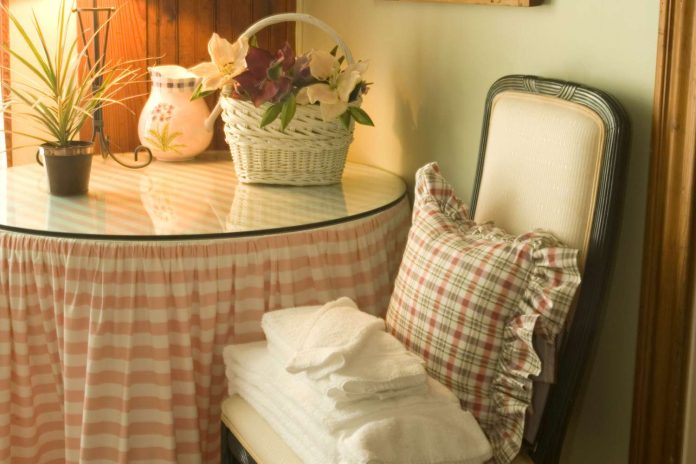My paternal grandmother, Sally Akin, was the queen of DIY. She cooked from scratch, sewed her family’s clothes, maintained her own garden, and crafted many of her holiday decorations. She carried this spirit of creativity into her home’s interiors as well. She sponge-painted walls, made her own window treatments, and even wallpapered a half bath with a custom collage of paper scraps. Her style was eclectic and warm, but most notably it was fluid and changing. My grandparents moved many times over her life, and each new house gave her the chance to switch things up decor wise. She had one secret weapon that was with her through all her changing addresses and home styles: the humble decorator table.
Getty Images
What Is A Decorator Table?
Those who were furnishing their homes in the 1990s might remember the decorator table trend. If you’re unfamiliar, it’s a relatively simple concept: a small pedestal accent table entirely covered by a piece of fabric, sometimes topped with a piece of glass. You’ll often see it in retail environments because it allows you to make a beautiful impact with a lower investment upfront. Some decorator tables themselves are made out of very cheap material, like particle board or wood composite, because you’ll never see the structure underneath. As long as the fabric on top is high-quality, it doesn’t really matter what the hidden table looks like.
Because my grandma was a skilled amateur seamstress, she always had gorgeous fabrics at home. This allowed her to change up her decorator table whenever she saw fit, whether that was after a move or just when she had a wild hair. If she painted her walls or if it was time for a seasonal switch-up, all she had to do was drape some new material over her pedestal and she had what seemed like a brand-new table. It let her to try new looks in her home without a large monetary investment, which was perfect for my famously frugal grandmother.
My mom, her daughter-in-law, also adopted this little trick in the house I grew up in, but because she is a much more traditional decorator, it stayed the same for most of my childhood. But that’s another beauty of a decorator table! It doesn’t have to change with the wind, but it can.
Change It Up
You might not want to invest in a new piece just to try out this old-school trick, but you can still embrace its spirit. Have an old piece of furniture that’s seen better days? Maybe the stain or paint has started coming off or your movers added some complimentary nicks and dings? Take a page out of my grandma’s book, and drape something beautiful over it. That could be a full tablecloth, a runner, or even something as small as a bandana. Adding fabric to your hard surfaces can hide imperfections, yes, but it also brings in texture, color, and interest.
I implement this little decorating tip mostly seasonally in my own home. The wooden table I use as a coffee station is usually bare, but when the cozy months come around, I love to cover it with a festive fabric. It helps take my dining room up a notch, whether it’s my orange jack-o-lantern Halloween tablecloth or the red-and-green textile I use during the Christmas season.
If you’re looking for a little variety in your home without a large price tag, the decorator table could be your new best friend.







